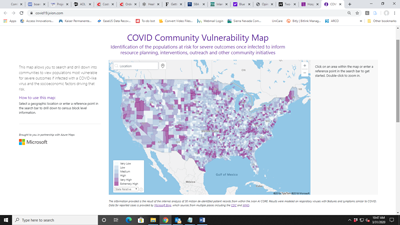Deploying SDoH Factors in the COVID Battle
By Clive Riddle, April 3, 2020
PWC’s Health Research Institute recent released: COVID-19: Six things health organizations should be considering (but might not be) offering six strategies that could be deployed in the fight against the pandemic. Number five on that list was SDoH:
“Strategies on social determinants of health can be an advantage in pandemic response. Trust-based relationships are important when people and communities are scared and unsure of what to do. Coalitions developed for pandemic response, much like social determinants of health interventions, should include trusted community organizations and providers that have access to hard-to-serve or underserved communities that may not be able to get information and support from traditional sources such as their employer or local government.”
A companion graphic noted "Less than 50% of primary care physicians said their practices coordinate with the right social service agencies.”
Health plans have come to embrace the SDoH component of removing economic barriers in treatment of COVID-19. While initially announcing waiver of any out-of-pocket costs for testing, more recently many health plans have issued announcements of waiving all treatment costs to consumers, including Aetna’s announcement on March 25th, Humana’s announcement and Cigna’s announcement on March 30th, followed by UnitedHealthcare on March 31st and Anthem on April 1st.
Also, numerous health plans are making sizeable donations to COVID-19 relief efforts in their markets, including these:
Harvard Pilgrim Health Care Foundation Gives More Than $3 Million for Covid-19 Relief Efforts
Medica Donates $1 Million to Minnesota Non-Profits to Meet Emergency Needs from the Coronavirus
21 Organizations to Receive First $500K of $1M Committed by the Tufts Health Plan Foundation
Health Net Rolls Out $5.9 Million in COVID-19 Assistance for Those Serving Medi-Cal Members
But a more proactive approach in leveraging SDoH in the COVID-19 battle is being offered by analytics technology companies. Two such approaches were profiled in the April Care Technology Edition of Care Analytics News, discussing Jvion’s new COVID Community Vulnerability Map and Clarify’s COVID-19 Elderly Vulnerability Population Index (EVI) and the Clarify COVID-19 Patient Risk Profile
Jvion’s COVID Community Vulnerability Map is built on Microsoft Azure maps, and enables healthcare providers and communities to identify the social determinants of health (SDoH) that put populations at greater risk during the COVID pandemic. Jvion states the map’s purpose is to inform “community planning and resource allocation to proactively mitigate the risk to vulnerable populations.” The Jvion COVID Community Vulnerability Map is available at https://covid19.jvion.com,

The interactive map identifies populations down to the census block level that are at risk for severe outcomes upon contracting a virus like COVID. Severe outcomes include hospitalization, organ failure and mortality. Additionally, the map surfaces the socioeconomic and environmental factors, such as lack of access to transportation or nutritious food, that put patients at greater risk. The map is also overlaid with points of interest, such as hospitals, food sources and transportation, in relation to the at-risk communities. These insights can help inform providers, public health organizations and community support agencies as they look to deploy interventions, outreach and other services to keep individuals from contracting the virus and, once infected, manage their care towards a positive outcome.
The map can quickly help local health departments prioritize their limited resources for response planning and adapt their tactics to the needs of neighborhoods and communities. By understanding the differentiated needs within their population, health systems can more adequately plan for healthcare utilization, deploy preventive or mitigating care resources, and anticipate the short-, mid- and long-term impacts of public health decisions, such as school and business closures.
Clarify Health announced that it launched two new critical applications in response to the needs of customers at the forefront of providing care to the communities impacted by COVID-19. The company is deploying the Clarify COVID-19 Elderly Vulnerability Population Index (EVI) and the Clarify COVID-19 Patient Risk Profile to healthcare organizations across the US to equip them with the patient risk insights that are needed to inform resource planning, interventions, and community initiatives.
The two applications leverage Clarify’s patient dataset, covering over 300 million lives, and AI capabilities. The solutions will reduce blind spots in patient risk by giving healthcare organizations access to an actionable COVID-19 vulnerability score for their elderly patients and a drill-down view into individual risk profiles and comorbidities at the point of care. Clarify’s COVID-19 EVI measures ZIP codes on relative vulnerability of seniors to severe coronavirus infection and delivers insights into their comorbidities, such as, cardiac diseases, respiratory diseases (including COPD), and cancer. The EVI provides hospitals, emergency services, health plans, and government agencies with the ability to identify neighborhoods which could benefit from greater testing or support services and prepare to take action quickly in high risk areas.
Clarify’s COVID-19 Patient Risk Profile is a web-based interface that highlights known risk factors for severe illness related to COVID-19. This capability is critical as frontline care providers struggle to proactively manage capacity and care for COVID-19 suspicious patients.
 Post a Comment By
Post a Comment By  Riddle, Clive |
Riddle, Clive |  Friday, April 3, 2020 at 09:10AM tagged
Friday, April 3, 2020 at 09:10AM tagged  Clinical & Quality|
Clinical & Quality|  Data & Technology
Data & Technology 

Reader Comments